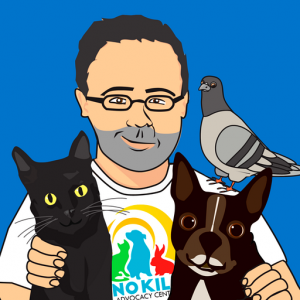I am a staunch believer in The No Kill Advocacy. There is never justification for shelters to use killing as their first chosen tool to manage animal population … never. Below is a blog post by Nathan Winograd, Founder of The No Kill Advocacy. I found it encouraging and inspiring, and I am republishing it here, with permission by the author and in its entirety, to encourage and inspire you as well. Until all of America’s shelters become true “shelters”, then this message is vital. Please see yourself in the lines of the following possibilities – what you personally can offer to advance the true welfare of our vulnerable animals. Every hand and every heart counts, no matter how seeming small the gesture. Much gratitude to Nathan Winograd for his undying bravery and fortitude on behalf of the pets who so desperately need our help, not our excuses.
* * *
Imagine the Possibilities

As reported earlier, an Austin Pets Alive director recently posted a “no-win” hypothetical designed to demonstrate the impossibility of No Kill. I responded that “I don’t believe in no-win scenarios” and showed how poor and incompetent leadership, and not a failure of No Kill, are to blame for Austin’s fall from grace.
To further respond to Austin Pets Alive’s cynical apologia, I’d like to offer a “hypothetical” of my own, one just as dire. But instead of accepting defeat, I’m asking people to imagine an outcome that recognizes our duty to animals and the people in our communities who love them.
Imagine You Run An Open-Admission Shelter.
Your intake rate is higher than the national average. Like most communities, you have pockets of affluence but also incredible poverty. You are getting your daily influx of animals. And then you get the call.
The state has requested assistance in closing down a puppy mill. They asked other shelters for help, but you would take the lead. In one day, you would get three times the number of dogs than the number of kennels you have, and you already have dogs in those kennels. As the animal control authority for all ten towns and cities in your county, you also get dogs daily.
On top of that, you are not just getting any dogs. While the other shelters are getting the puppies, you are getting the dogs used for breeding. Most of these dogs have severe conditions or other challenges: dogs with untreated tumors, dogs with rotten teeth, dogs with neurological problems who walk in circles, under-socialized dogs, heavily traumatized dogs, dogs matted from head to toe who are painful to touch, blind dogs who lived inside pet carriers their whole lives.
What Would You Do?
We know what would happen at the shelters that Austin Pets Alive champions, such as those in Philadelphia, Memphis, El Paso, and Los Angeles. After killing the dogs, the Executive Director would talk about “public irresponsibility,” saying the dogs were “unadoptable,” and how “euthanasia” relieved them of their suffering. “Public irresponsibility,” “unadoptable,” and “euthanasia” are all code words that show a profound lack of imagination.
If you chose to kill the dogs, too, Austin Pets Alive would not criticize you for it. Instead, they would circle the wagons around you, claiming the fault lies with the puppy mill. And there is some truth there: Fault does lie with the puppy mill for exploiting, neglecting, and abusing those poor dogs. But once the dogs are in the care of the shelter, the calculus changes. Whether those dogs live or die is now up to the shelter. At that point, the only choice is whether the shelter will perpetuate the harm by killing them or whether it won’t.
In Sheltering, We Like To Fall Back On The Cliché That Killing Is A Last Resort.
But while shelter directors give lip service to that, it often is a first resort: The thing that is routinely and casually done when the cages get full. The thing that is done even when they aren’t full. Because that is just what we’ve done in shelters for over 100 years, and collectively, these pounds stopped imagining a different outcome. But in reality, this “solution” is the most extreme, inhumane, and violent of all possible responses.
Imagine Child Protective Services taking in abused, abandoned, and homeless children and then killing them. It is unthinkable. As a society, we should no more tolerate it for animals. Indeed, if we had never started killing, the suggestion that we should do so would be preposterous. Yet custom has reconciled those running animal shelters to view it as inevitable.

So What Would Happen If You Threw Out The Calculus?
What would happen if, instead of debating whether the killing was the first or the last resort, it was no resort? What if you took killing off of the table? The pro-killing Naysayers argue that you would become a hoarder: the animals would pile up and get sick. But the Naysayers are wrong. There are communities across the country, including those with extremely high intake rates — almost ten times the rate of New York City, the most congested urban area in the United States — that have done it: with sustained placement rates of 99%. And the two things they all have in common are leaders with a “can do” attitude — with imagination — and the No Kill Equation.
So where will you house the dogs? Who will provide the triage? Who will treat the rotten teeth, the tumors, and the matted fur? How will you adopt them? This is the scenario I faced several years ago when I ran an animal shelter in New York. And here is what happened.
First, I employed an essential trait of any leader: staying in control. If you are confident, your staff will be confident. If you believe, the volunteers will believe. Then I employed a bit of imagination. What if we put up a big tent outside to house the dogs? So I called a local party rental store and asked them to donate a wedding tent in exchange for promoting how they helped us save lives. Whatever the circumstances, it was my job to imagine a solution. If it didn’t work, it was my job to imagine another solution. Leaders do not throw up their hands and say if we can’t do this one thing (killing or refusing to take them in), there isn’t anything else we can do.
What if we created the equivalent of a MASH hospital by issuing an all-hands-on-deck call to volunteers and staff, bringing them in on their off days? Not enough veterinarians? What if I called my daughter’s orthodontist to help with rotten dog teeth? If a door is closed, you open it. If it is locked, you kick it down. If it is reinforced, you smash a window.
That Is What I Did.
And when the vans arrived and the officers carried off the dogs, it was an awesome sight to behold. Volunteers had established an assembly line bathing the dogs, delicately cutting the mats, and cutting toenails. A local veterinarian canceled her appointments and spent the day doing triage, with staff acting as assistants, and then spent the evening doing surgeries. A local dentist came in to clean, fix, and pull teeth. The media was there with cameras rolling, we reached out to rescue partners in five states, and we kept the shelter open late for adoptions. As long as people came in, our adoption floor was open for business.
We had already created the infrastructure necessary to save lives. We had the No Kill Equation in place — foster care, comprehensive adoption programs, socialization and behavior rehabilitation, medical care, working with rescue groups, marketing and promotions, a robust volunteer base, and more. These programs allow a shelter to save lives not just in ordinary circumstances but could be called upon to give more during extraordinary ones.
All I had to do was create an environment and provide the tools that allowed people to help. When you make it easy for people to do the right thing, they will. And within 48 hours, we had emptied the shelter without a single dog losing his life, without even unfurling the big tent.
Of Course, We Owe It To The Animals To Do These Things.
That goes without saying. But we also owe it to people — the people clamoring for change in their communities. The people fighting shelters that refuse to do these things, but who would be a shelter’s biggest cheerleaders and fiercest allies if shelter directors stopped viewing them as enemies and partnered with them to save lives. Killing those dogs would have been unfair to the volunteers who gladly spent the day caring for them and unfair to the human orthodontist who talked about that day years later. They had so much to give and would have felt so much anguish had our “solution” been simply to kill. A leader’s job is to give people the opportunity to help, not to turn them away with platitudes about public irresponsibility and the inevitability of killing.
Recently, a reporter asked me what I thought was the most important trait a county or city should look for when hiring someone to run the local shelter. I thought of a few: past success, a passion for saving lives, a belief in one’s duty to animals and the community, and the ability to get results. But, when all is said and done, the most important trait of all is imagination. If you can imagine a different outcome than killing; a different outcome than closing your doors to animals in need; if when faced with adversity, you can imagine how you might do things differently; and you permit yourself to try it even when conventional wisdom says you should not; you’re already more prepared than the vast majority of shelter directors in this country. Because, unfortunately, for far too many shelter directors and in far too many “animal protection” organizations, imagination is in tragically short supply.
To receive future articles and support my fight for the animals, please subscribe.

* * *
* * * * * * * * * * * * * * * * * * * * * * * * *
God Bless and Happy Pet Parenting!
With love and good wishes,
jeannie. ?
About jeannie: I’ve been pro-actively involved in pet rescue all of my life. I founded Milagro Senior Pet Refuge© (Phoenix) in 1998, and BareFootPets (TM) in 2008. Animal welfare has always been and will always be my heart’s work. If my only legacy is that I save a handful of precious souls that would not survive otherwise, I’m good with that.

